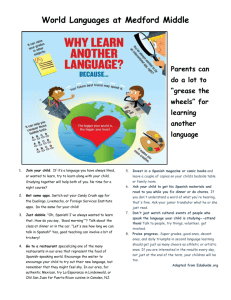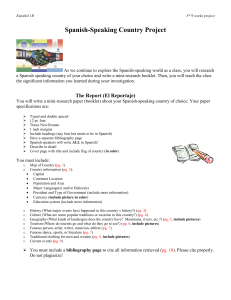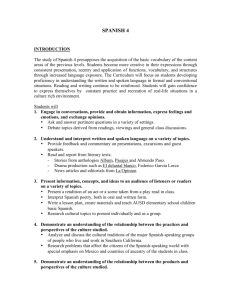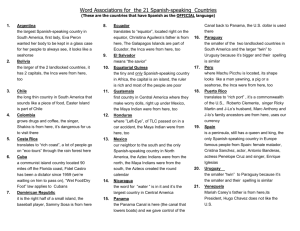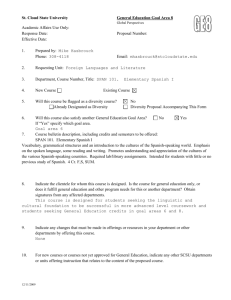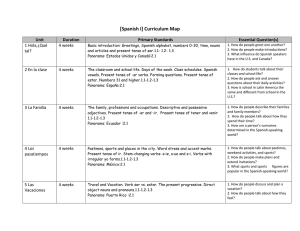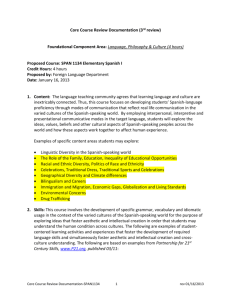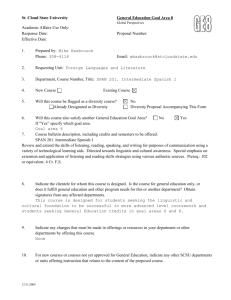Spanish 1 Overview - Elliott County Schools
advertisement
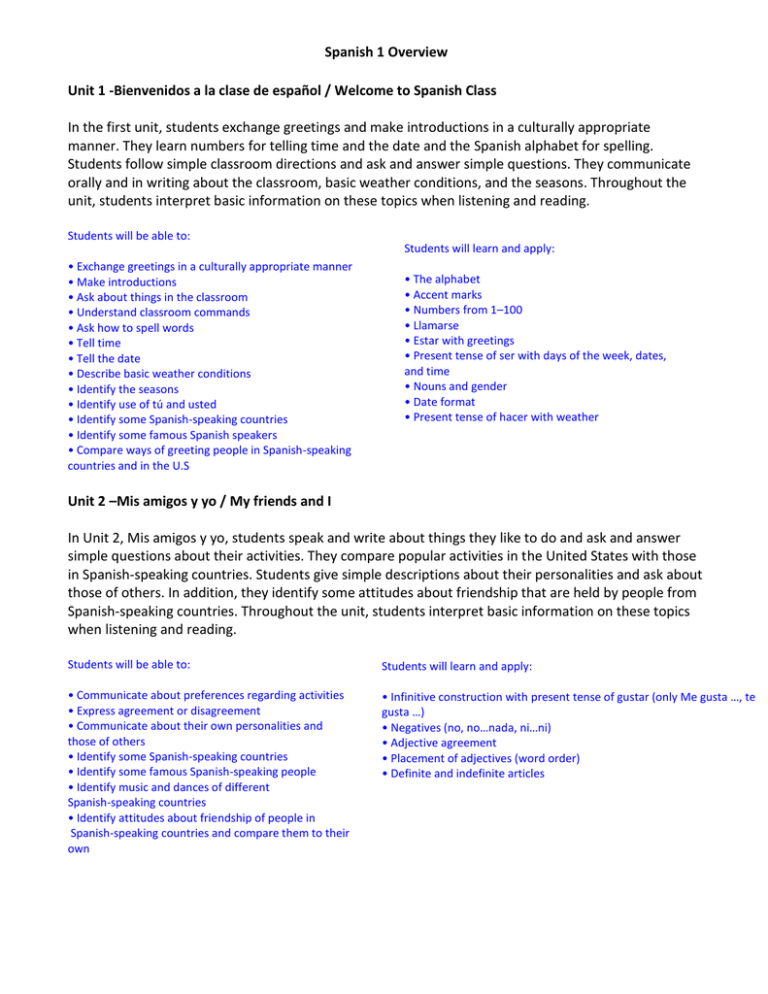
Spanish 1 Overview Unit 1 -Bienvenidos a la clase de español / Welcome to Spanish Class In the first unit, students exchange greetings and make introductions in a culturally appropriate manner. They learn numbers for telling time and the date and the Spanish alphabet for spelling. Students follow simple classroom directions and ask and answer simple questions. They communicate orally and in writing about the classroom, basic weather conditions, and the seasons. Throughout the unit, students interpret basic information on these topics when listening and reading. Students will be able to: Students will learn and apply: • Exchange greetings in a culturally appropriate manner • Make introductions • Ask about things in the classroom • Understand classroom commands • Ask how to spell words • Tell time • Tell the date • Describe basic weather conditions • Identify the seasons • Identify use of tú and usted • Identify some Spanish-speaking countries • Identify some famous Spanish speakers • Compare ways of greeting people in Spanish-speaking countries and in the U.S • The alphabet • Accent marks • Numbers from 1–100 • Llamarse • Estar with greetings • Present tense of ser with days of the week, dates, and time • Nouns and gender • Date format • Present tense of hacer with weather Unit 2 –Mis amigos y yo / My friends and I In Unit 2, Mis amigos y yo, students speak and write about things they like to do and ask and answer simple questions about their activities. They compare popular activities in the United States with those in Spanish-speaking countries. Students give simple descriptions about their personalities and ask about those of others. In addition, they identify some attitudes about friendship that are held by people from Spanish-speaking countries. Throughout the unit, students interpret basic information on these topics when listening and reading. Students will be able to: Students will learn and apply: • Communicate about preferences regarding activities • Express agreement or disagreement • Communicate about their own personalities and those of others • Identify some Spanish-speaking countries • Identify some famous Spanish-speaking people • Identify music and dances of different Spanish-speaking countries • Identify attitudes about friendship of people in Spanish-speaking countries and compare them to their own • Infinitive construction with present tense of gustar (only Me gusta …, te gusta …) • Negatives (no, no…nada, ni…ni) • Adjective agreement • Placement of adjectives (word order) • Definite and indefinite articles Unit 3 - La escuela / School In this unit, La escuela, students exchange information, orally and in writing, about their school schedules and their classes. They describe classrooms including the location of objects. Students also describe the school day in Spanish-speaking countries and make comparisons with their own. Throughout the unit, students interpret basic information on school when listening and reading. Students will be able to: Students will learn and apply: • Communicate about school schedules and course preferences • Describe their school day • Communicate about their classroom and the location of items • Identify some Spanish-speaking countries • Identify courses students take in Spanish-speaking countries and compare them to courses taken in the U.S. • Identify attitudes about school in Spanish-speaking countries and compare them to those in the U.S. • Subject pronouns • Present tense of –ar verbs • Present tense of estar • Prepositions of location • Plurals of nouns and articles • De to indicate possession Unit 4 - La comida / Food In Unit 4, La comida, students exchange information, orally and in writing, about basic foods for breakfast, lunch, and dinner. They exchange preferences regarding food choices and communicate about ways to maintain their health. In addition, students identify common foods as well as eating habits in Spanish-speaking countries and compare them with their own. Throughout the unit, students interpret basic information on these topics when listening and reading. Students will be able to: Students will learn and apply: • Communicate about food and beverages for breakfast, lunch, and dinner • Communicate about preferences for foods and beverages. • Communicate about foods and exercise to maintain one’s health • Identify some Spanish-speaking countries • Identify foods and beverages from Spanish-speaking countries and compare them to those in the U.S. • Describe breakfast in Spanish-speaking countries and compare it to breakfast in the U.S. • Present tense of –er and -ir verbs • Adverbs and expressions of frequency • Use of present tense of gustar and encantar with plural nouns • Plural of adjectives • Present tense of ser Unit 5 – Los pasatiempos / Pastimes In Unit 5, Los pasatiempos, students exchange basic information, orally and in writing, about their pastimes and places in the community. They ask and answer simple questions and talk about afterschool activities both in the United States and in Spanish-speaking countries. In addition, they learn how to extend and respond to invitations. Throughout the unit, students interpret basic information on pastimes when listening and reading. Students will be able to: Students will learn and apply: • Communicate about pastimes • Present tense of ir • Extend, accept, and decline invitations • Question words • Communicate about places in the community • Near future (ir a + infinitive) • Identify some Spanish-speaking countries • Present tense of jugar • Identify some famous Spanish-speaking people • Identify pastimes in Spanish-speaking countries and compare them to those in the U.S.
